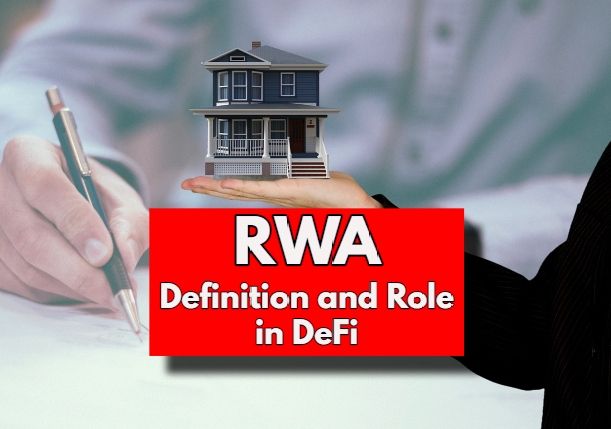RWA: Definition and Role in DeFi. Find out what RWAs are, and how they are playing an increasingly important role in DeFi.
RWA: Definition and Role in DeFi increasingly important through tokenization. If you follow decentralized finance news, then you’re hearing more and more about RWA, but what is it and how does it relate to DeFi.
RWA: Definition
Real-world assets refer to physical or tangible items that have value in the traditional economy. These assets can range from commodities, like gold and oil, to real estate, cars, and financial instruments like stocks, bonds, or even invoices. Traditionally, these assets are part of centralized markets, where ownership and transfer are managed through legal documents, regulatory frameworks, and intermediaries like banks or custodians.
RWA: definition, to fully understand what’s going on, we also need to go back to what DeFi is all about. By combining the definition of RWA with that of DeFi, we can better understand the major impact this will have on the international financial landscape.
Introduction to Decentralized Finance (DeFi)
Decentralized finance (DeFi) has emerged as one of the most innovative sectors in the blockchain and cryptocurrency space. DeFi offers financial services, such as lending, borrowing, trading, and asset management, without relying on traditional financial intermediaries like banks or brokers. Instead, these services are facilitated through smart contracts and blockchain technology. DeFi’s open-access, transparency, and global availability have fueled its rapid growth, creating new possibilities for financial inclusivity.
One of the most exciting developments in DeFi is the integration of Real-World Assets (RWA) into decentralized platforms. Tokenizing physical assets and representing them on a blockchain has opened a new frontier in the financial world. This article explores the concept of RWA, its tokenization, and its role in revolutionizing DeFi.
Tokenizing these assets involves creating a digital representation (or token) on the blockchain. For example, a real estate property could be represented as a non-fungible token (NFT) or as divisible shares, enabling the asset to be transferred or traded digitally. Once tokenized, the ownership, transfer, and other rights related to the asset can be managed through blockchain smart contracts. The value of the real-world asset is thus captured and made accessible on decentralized financial platforms.
The Growing Involvement of RWA in DeFi
DeFi, which began as a decentralized alternative to traditional financial products, has mostly dealt with cryptocurrencies as collateral or assets. However, the introduction of RWA into DeFi is pushing the boundaries of what’s possible, merging real-world value with digital financial instruments.
Here’s how RWA is involved in the DeFi ecosystem:
-
Tokenization of Assets
Tokenization is the foundation of integrating RWA into DeFi. By tokenizing real-world assets, you effectively convert physical assets into a digital format that can be tracked, traded, and utilized on blockchain platforms. Whether it’s real estate, vehicles, commodities, or stocks, tokenization enables DeFi protocols to recognize and incorporate these assets into decentralized systems.For example, a real estate token could represent ownership or shares in a physical property. Through fractionalization, smaller investors who may not be able to purchase an entire building or land can own portions of the property. This democratizes access to investments typically reserved for high-net-worth individuals or institutional investors.
-
Collateralization in DeFi Lending
In traditional finance, you can use assets like real estate or stocks as collateral to secure loans. In DeFi, cryptocurrencies have been the primary form of collateral. However, with tokenized RWA, the collateral pool expands to include real-world items like homes, cars, or gold.This means a user can deposit tokenized real estate into a DeFi lending protocol as collateral and borrow stablecoins or other cryptocurrencies against it. Platforms like Centrifuge and MakerDAO are already experimenting with RWA-backed loans, allowing borrowers to use tokenized invoices or real estate as collateral. This development is crucial as it allows for the mobilization of trillions of dollars in real-world value that was previously inaccessible to the DeFi ecosystem.
-
Liquidity and Market Expansion
One of the primary limitations of real-world assets is their illiquidity. Real estate, for example, cannot be quickly or easily sold for cash, and selling a part of a property is even more challenging. Tokenizing RWA and using them in DeFi can create secondary markets for these assets, making them far more liquid.With DeFi protocols, tokenized assets can be traded 24/7 in global markets, increasing liquidity and giving investors the flexibility to sell or leverage assets as needed. By allowing these assets to circulate in decentralized markets, DeFi expands the scope of its liquidity pools, which were previously limited to cryptocurrencies.
-
Yield Generation and Passive Income
Tokenized real-world assets can generate passive income through staking or yield farming. For example, a tokenized property could generate rental income that is distributed proportionally to its token holders via smart contracts. This automated process ensures transparency and accuracy in income distribution. Similarly, tokenized commodities or stocks can generate dividends or interest, allowing DeFi users to earn yield from traditional investments.Platforms like RealT enable investors to buy tokenized real estate properties and receive rental payments in stablecoins like DAI. This concept introduces a whole new way for real-world assets to generate income through DeFi mechanisms, making it a potentially lucrative venture for long-term investors.
-
Reduced Entry Barriers and Democratization of Finance
The fractionalization of assets through tokenization lowers the barriers to entry for investors who may not have the capital required for larger, traditional investments. For example, instead of needing millions of dollars to invest in a piece of prime real estate, tokenization allows small investors to purchase fractions of that property. This democratizes access to financial opportunities that were previously exclusive to wealthy or institutional investors.In addition, RWA tokens can be bought, sold, or traded by anyone with an internet connection, further breaking down geographical and financial barriers. DeFi’s open and permissionless nature enhances this democratization, making it possible for people from all walks of life to access investments in tokenized real-world assets.
Transparency, Security, and Compliance
One of the key advantages of blockchain technology is its transparency. Every transaction, transfer of ownership, and collateralization event is recorded immutably on the blockchain, reducing the risks of fraud or mismanagement. This transparency is particularly valuable in managing real-world assets, where issues like unclear ownership or misappropriation of funds can cause problems in traditional systems.
Smart contracts also bring automation and security to the process. For example, when tokenized assets are used as collateral, the terms of the loan or rental agreement are enforced automatically by the smart contract, reducing the need for intermediaries and minimizing the risk of human error or manipulation.
However, the integration of RWA into DeFi also comes with regulatory challenges. Real-world assets are subject to legal frameworks, and transferring ownership digitally must comply with existing laws. While DeFi operates in a decentralized and often permissionless environment, the need for compliance with asset-backed tokens may involve working with regulatory authorities and meeting legal requirements for issuing and trading tokenized securities, commodities, or property.
RWA: Definition and Role in DeFi – Conclusion
The integration of real-world assets (RWA) into decentralized finance represents a significant leap toward bridging the gap between traditional finance and DeFi. By tokenizing physical assets, DeFi platforms can unlock new liquidity sources, provide innovative financial products, and democratize access to investments. The benefits of using RWA in DeFi are far-reaching, from increasing the liquidity of illiquid assets to creating new opportunities for passive income generation.
Despite the challenges, such as regulatory compliance and ensuring legal clarity, the potential for growth and innovation in this space is immense. As the DeFi ecosystem continues to evolve, the role of RWA in decentralized finance will likely expand, providing new avenues for wealth creation and financial inclusivity on a global scale.

